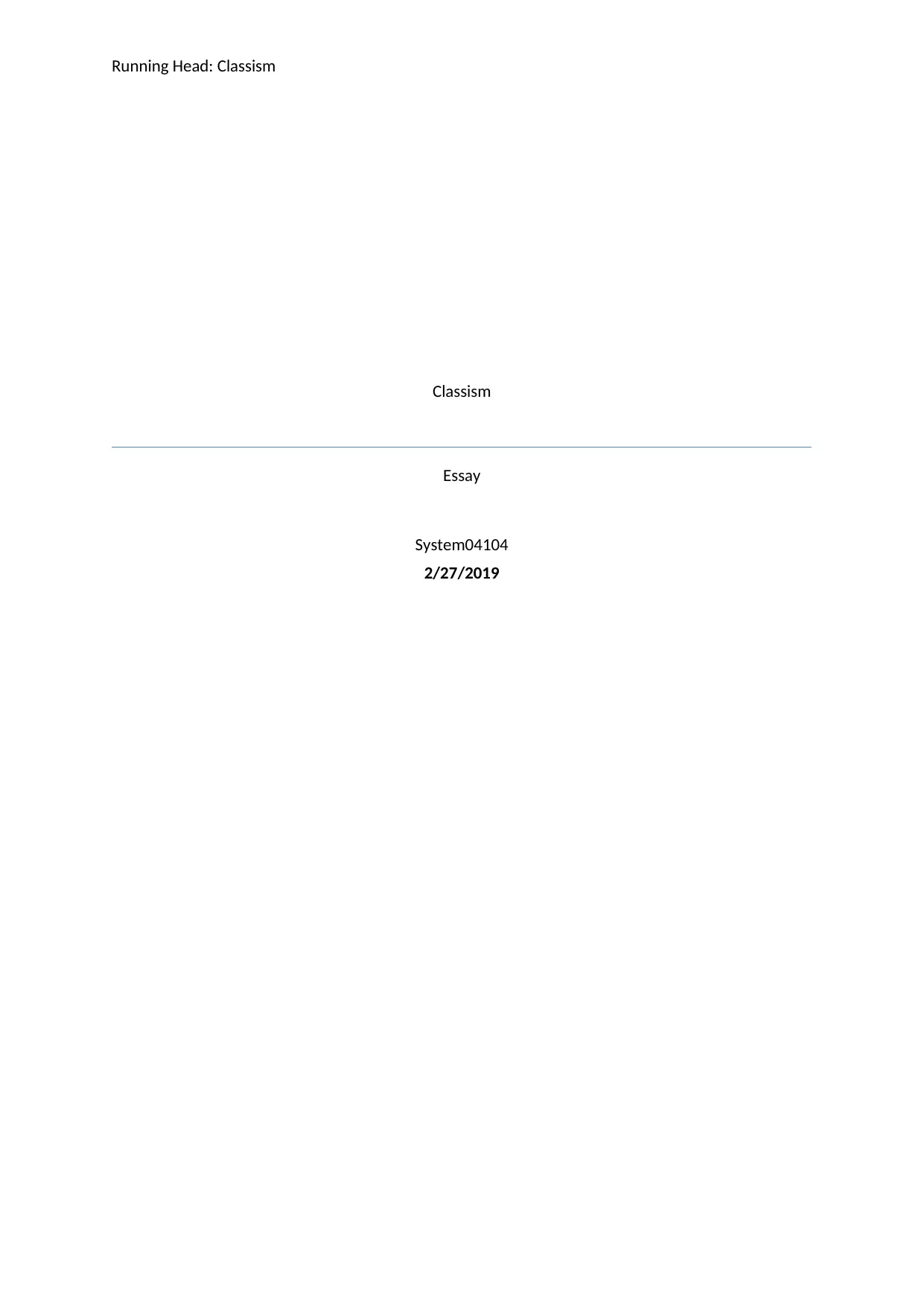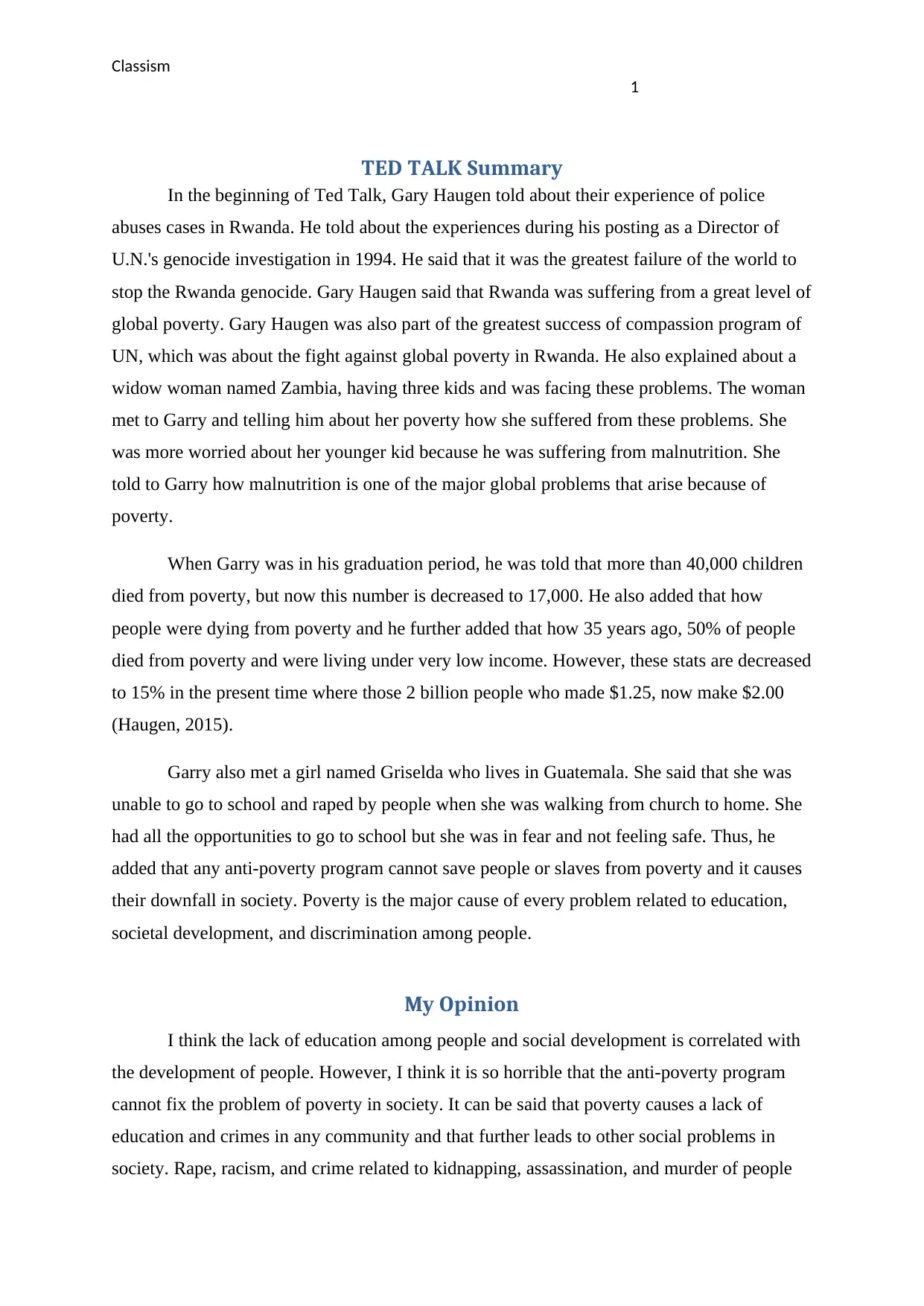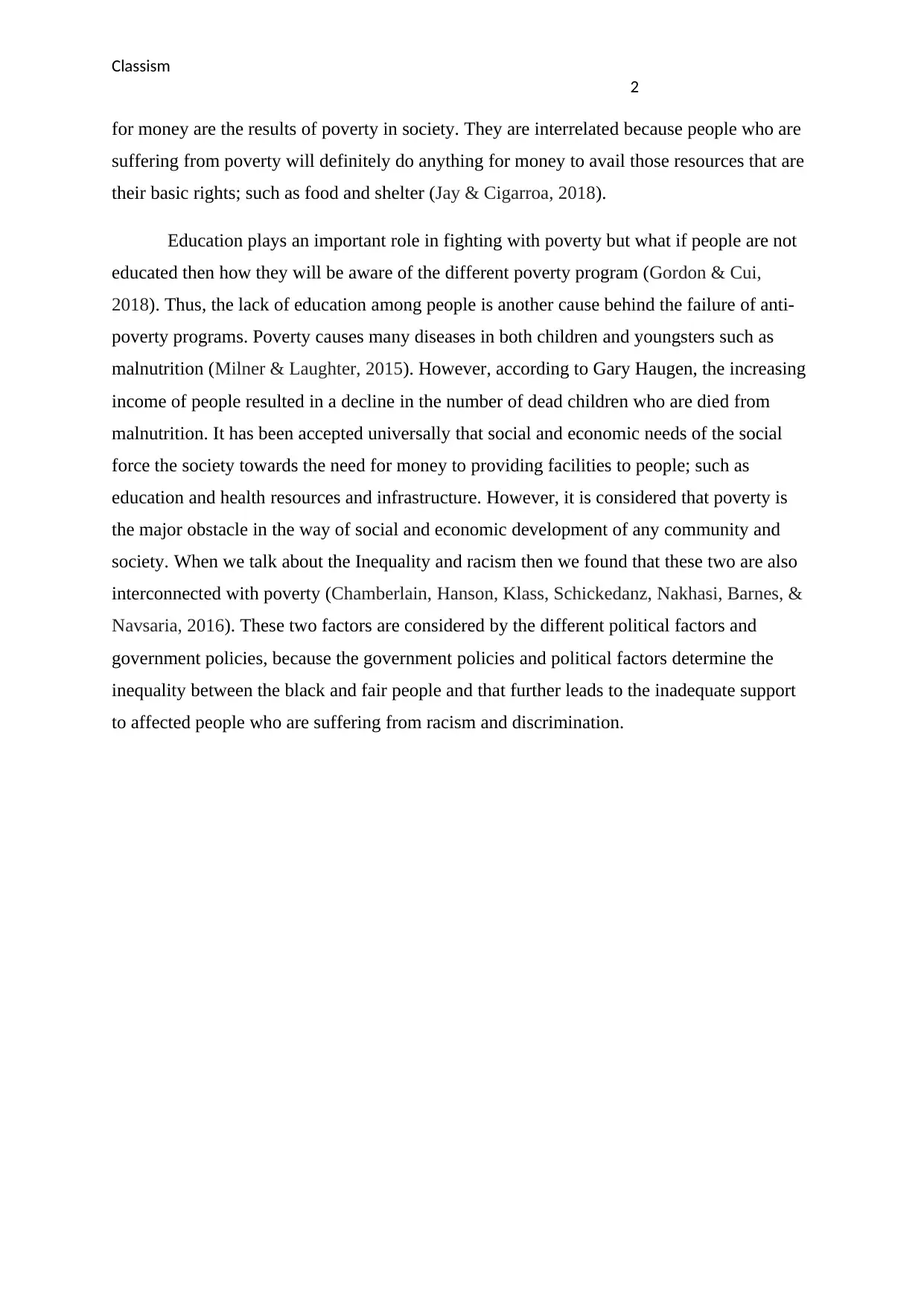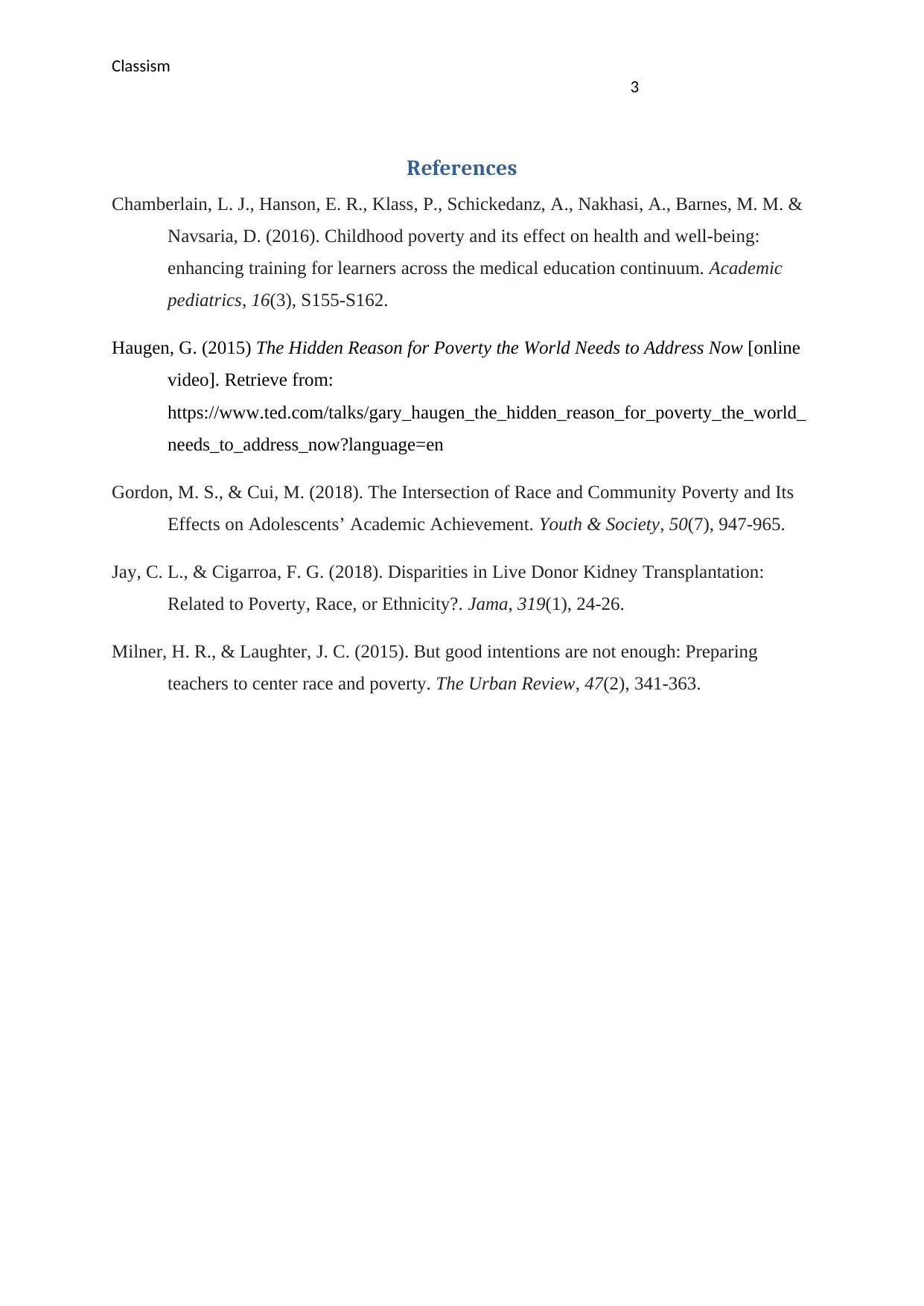Classism Essay: Analyzing Poverty, Inequality, and Social Development
VerifiedAdded on 2023/04/23
|4
|980
|326
Essay
AI Summary
This essay summarizes a TED Talk by Gary Haugen, focusing on his experiences with poverty and injustice in Rwanda and Guatemala. It highlights the failure of anti-poverty programs to address the root causes of poverty, such as lack of education and social development. The essay also explores the correlation between poverty and social issues like rape, racism, and crime. It argues that poverty leads to a lack of access to basic resources and perpetuates a cycle of inequality. Furthermore, the essay emphasizes the interconnectedness of poverty, inequality, and racism, noting that government policies can exacerbate these issues. The author suggests that addressing poverty requires a comprehensive approach that includes education, social development, and fair policies.

Running Head: Classism
Classism
Essay
System04104
2/27/2019
Classism
Essay
System04104
2/27/2019
Paraphrase This Document
Need a fresh take? Get an instant paraphrase of this document with our AI Paraphraser

Classism
1
TED TALK Summary
In the beginning of Ted Talk, Gary Haugen told about their experience of police
abuses cases in Rwanda. He told about the experiences during his posting as a Director of
U.N.'s genocide investigation in 1994. He said that it was the greatest failure of the world to
stop the Rwanda genocide. Gary Haugen said that Rwanda was suffering from a great level of
global poverty. Gary Haugen was also part of the greatest success of compassion program of
UN, which was about the fight against global poverty in Rwanda. He also explained about a
widow woman named Zambia, having three kids and was facing these problems. The woman
met to Garry and telling him about her poverty how she suffered from these problems. She
was more worried about her younger kid because he was suffering from malnutrition. She
told to Garry how malnutrition is one of the major global problems that arise because of
poverty.
When Garry was in his graduation period, he was told that more than 40,000 children
died from poverty, but now this number is decreased to 17,000. He also added that how
people were dying from poverty and he further added that how 35 years ago, 50% of people
died from poverty and were living under very low income. However, these stats are decreased
to 15% in the present time where those 2 billion people who made $1.25, now make $2.00
(Haugen, 2015).
Garry also met a girl named Griselda who lives in Guatemala. She said that she was
unable to go to school and raped by people when she was walking from church to home. She
had all the opportunities to go to school but she was in fear and not feeling safe. Thus, he
added that any anti-poverty program cannot save people or slaves from poverty and it causes
their downfall in society. Poverty is the major cause of every problem related to education,
societal development, and discrimination among people.
My Opinion
I think the lack of education among people and social development is correlated with
the development of people. However, I think it is so horrible that the anti-poverty program
cannot fix the problem of poverty in society. It can be said that poverty causes a lack of
education and crimes in any community and that further leads to other social problems in
society. Rape, racism, and crime related to kidnapping, assassination, and murder of people
1
TED TALK Summary
In the beginning of Ted Talk, Gary Haugen told about their experience of police
abuses cases in Rwanda. He told about the experiences during his posting as a Director of
U.N.'s genocide investigation in 1994. He said that it was the greatest failure of the world to
stop the Rwanda genocide. Gary Haugen said that Rwanda was suffering from a great level of
global poverty. Gary Haugen was also part of the greatest success of compassion program of
UN, which was about the fight against global poverty in Rwanda. He also explained about a
widow woman named Zambia, having three kids and was facing these problems. The woman
met to Garry and telling him about her poverty how she suffered from these problems. She
was more worried about her younger kid because he was suffering from malnutrition. She
told to Garry how malnutrition is one of the major global problems that arise because of
poverty.
When Garry was in his graduation period, he was told that more than 40,000 children
died from poverty, but now this number is decreased to 17,000. He also added that how
people were dying from poverty and he further added that how 35 years ago, 50% of people
died from poverty and were living under very low income. However, these stats are decreased
to 15% in the present time where those 2 billion people who made $1.25, now make $2.00
(Haugen, 2015).
Garry also met a girl named Griselda who lives in Guatemala. She said that she was
unable to go to school and raped by people when she was walking from church to home. She
had all the opportunities to go to school but she was in fear and not feeling safe. Thus, he
added that any anti-poverty program cannot save people or slaves from poverty and it causes
their downfall in society. Poverty is the major cause of every problem related to education,
societal development, and discrimination among people.
My Opinion
I think the lack of education among people and social development is correlated with
the development of people. However, I think it is so horrible that the anti-poverty program
cannot fix the problem of poverty in society. It can be said that poverty causes a lack of
education and crimes in any community and that further leads to other social problems in
society. Rape, racism, and crime related to kidnapping, assassination, and murder of people

Classism
2
for money are the results of poverty in society. They are interrelated because people who are
suffering from poverty will definitely do anything for money to avail those resources that are
their basic rights; such as food and shelter (Jay & Cigarroa, 2018).
Education plays an important role in fighting with poverty but what if people are not
educated then how they will be aware of the different poverty program (Gordon & Cui,
2018). Thus, the lack of education among people is another cause behind the failure of anti-
poverty programs. Poverty causes many diseases in both children and youngsters such as
malnutrition (Milner & Laughter, 2015). However, according to Gary Haugen, the increasing
income of people resulted in a decline in the number of dead children who are died from
malnutrition. It has been accepted universally that social and economic needs of the social
force the society towards the need for money to providing facilities to people; such as
education and health resources and infrastructure. However, it is considered that poverty is
the major obstacle in the way of social and economic development of any community and
society. When we talk about the Inequality and racism then we found that these two are also
interconnected with poverty (Chamberlain, Hanson, Klass, Schickedanz, Nakhasi, Barnes, &
Navsaria, 2016). These two factors are considered by the different political factors and
government policies, because the government policies and political factors determine the
inequality between the black and fair people and that further leads to the inadequate support
to affected people who are suffering from racism and discrimination.
2
for money are the results of poverty in society. They are interrelated because people who are
suffering from poverty will definitely do anything for money to avail those resources that are
their basic rights; such as food and shelter (Jay & Cigarroa, 2018).
Education plays an important role in fighting with poverty but what if people are not
educated then how they will be aware of the different poverty program (Gordon & Cui,
2018). Thus, the lack of education among people is another cause behind the failure of anti-
poverty programs. Poverty causes many diseases in both children and youngsters such as
malnutrition (Milner & Laughter, 2015). However, according to Gary Haugen, the increasing
income of people resulted in a decline in the number of dead children who are died from
malnutrition. It has been accepted universally that social and economic needs of the social
force the society towards the need for money to providing facilities to people; such as
education and health resources and infrastructure. However, it is considered that poverty is
the major obstacle in the way of social and economic development of any community and
society. When we talk about the Inequality and racism then we found that these two are also
interconnected with poverty (Chamberlain, Hanson, Klass, Schickedanz, Nakhasi, Barnes, &
Navsaria, 2016). These two factors are considered by the different political factors and
government policies, because the government policies and political factors determine the
inequality between the black and fair people and that further leads to the inadequate support
to affected people who are suffering from racism and discrimination.
⊘ This is a preview!⊘
Do you want full access?
Subscribe today to unlock all pages.

Trusted by 1+ million students worldwide

Classism
3
References
Chamberlain, L. J., Hanson, E. R., Klass, P., Schickedanz, A., Nakhasi, A., Barnes, M. M. &
Navsaria, D. (2016). Childhood poverty and its effect on health and well-being:
enhancing training for learners across the medical education continuum. Academic
pediatrics, 16(3), S155-S162.
Haugen, G. (2015) The Hidden Reason for Poverty the World Needs to Address Now [online
video]. Retrieve from:
https://www.ted.com/talks/gary_haugen_the_hidden_reason_for_poverty_the_world_
needs_to_address_now?language=en
Gordon, M. S., & Cui, M. (2018). The Intersection of Race and Community Poverty and Its
Effects on Adolescents’ Academic Achievement. Youth & Society, 50(7), 947-965.
Jay, C. L., & Cigarroa, F. G. (2018). Disparities in Live Donor Kidney Transplantation:
Related to Poverty, Race, or Ethnicity?. Jama, 319(1), 24-26.
Milner, H. R., & Laughter, J. C. (2015). But good intentions are not enough: Preparing
teachers to center race and poverty. The Urban Review, 47(2), 341-363.
3
References
Chamberlain, L. J., Hanson, E. R., Klass, P., Schickedanz, A., Nakhasi, A., Barnes, M. M. &
Navsaria, D. (2016). Childhood poverty and its effect on health and well-being:
enhancing training for learners across the medical education continuum. Academic
pediatrics, 16(3), S155-S162.
Haugen, G. (2015) The Hidden Reason for Poverty the World Needs to Address Now [online
video]. Retrieve from:
https://www.ted.com/talks/gary_haugen_the_hidden_reason_for_poverty_the_world_
needs_to_address_now?language=en
Gordon, M. S., & Cui, M. (2018). The Intersection of Race and Community Poverty and Its
Effects on Adolescents’ Academic Achievement. Youth & Society, 50(7), 947-965.
Jay, C. L., & Cigarroa, F. G. (2018). Disparities in Live Donor Kidney Transplantation:
Related to Poverty, Race, or Ethnicity?. Jama, 319(1), 24-26.
Milner, H. R., & Laughter, J. C. (2015). But good intentions are not enough: Preparing
teachers to center race and poverty. The Urban Review, 47(2), 341-363.
1 out of 4
Your All-in-One AI-Powered Toolkit for Academic Success.
+13062052269
info@desklib.com
Available 24*7 on WhatsApp / Email
![[object Object]](/_next/static/media/star-bottom.7253800d.svg)
Unlock your academic potential
Copyright © 2020–2025 A2Z Services. All Rights Reserved. Developed and managed by ZUCOL.